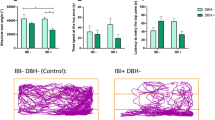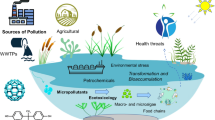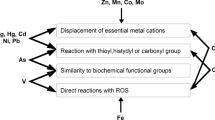Abstract
Temperature from 12 to 22°C and salinity from 30.5 to 7.6‰ increased accumulation of copper in Hediste diversicolor. Copper accumulated ranged from 85.83 to 217.14 μg g-1. Sediments reduced accumulation of copper under temperature-salinity combinations. Accumulated copper ranged from 90.19 to 153.26 μg g-1.
However, mortality of the worms was not solely dependent upon copper body-burden. It ranged from 34 to 45% and from 38 to 80% in the presence of sediment. A combination of osmoregulatory and thermal stresses increased the toxic effect of copper to the worms.
Similar content being viewed by others
References
Barnett, B. E. and Aschroft, C. R.: 1985, ‘Heavy metals in Fucus vesiculosus in the Humber Estuary’, Environ. Pollut. (Series B), 9, 193–213.
Bryan, G. W.: 1971, ‘The Effects of Heavy Metals Other Than Mercury on Marine and Estuarine Organisms’, Proc. Royal Soc. B. London 177, 389–410.
Cairns, J. Jr., Health, A. G., and Parker, B. C.: 1975, ‘The Effects of Temperature upon the Toxicity of Zinc to the Common Bluegill (Lepomis Macrochirus, Raf.) Notulae Natur’, (Philadelphia) 299, 1–12.
Gameson, A. L. H. (ed.): 1982, ‘The Quality of the Humber Estuary’, A review of the results of monitoring 1961–1981. Published by the Yorkshire Water Authority on behalf of the Humber Estuary Committee. pp 88.
Howard, L. S. and Brown, B. E.: 1983, ‘Natural Variations in Tissue Concentration of Copper, Zinc and Iron in the Polychaete Nereis diversicolor’. Mar. Biol. 78, 87–97.
Kinne, O.: 1958, ‘Adaptation to Salinity Variations — Some Facts and Problems’, in Prosser, C. L. (ed.), Physiological Adaptation. Am. Physiol. Soc. Wash. D.C. pp 92–106.
Mclusky, D. S., Bryant, V., and Campbell, R.: 1986, ‘The Effects of Temperature and Salinity on the Toxicity of Heavy Metals to Marine and Estuarine Invertebrates’, Oceanogr. Mar. Biol. 24, 481–520.
Oglesby, L. C.: 1970, ‘Studies on the Salt and Water Balance of Nereis diversicolor. I. Steady — State Parameters’, Comp. Bochem. Physiol. 36, 449–466.
Ozoh, P. T. E.: 1986, ‘Studies on the Toxicity of Copper to Various Stages in the Life Cycle of Hediste (Nereis) diversicolor (O. F. Muller); Ph.D. Thesis University of Hull, p. 127.
Ozoh, P. T. E. and Jones, N. V.: 1988, ‘The Effects of Copper Ions on Embryogenesis in the Polychaete Hediste (Nereis) diversicolor’, Mar. Environ. Res. 24, (1–4) 255–256.
Ozoh, P. T. E. and Jones, N. V.: 1990a, ‘The Effects of Salinity and Temperature on the Toxicity of Copper to 1-day day and 7-day old Larvae of Hediste (Nereis) diversicolor (O. F. Muller)’, Ecotoxicol. Environ. Saf. 19, 24–32.
Ozoh, P. T. E. and Jones, N. V.: 1990b, ‘Capacity Adaption of Hediste (Nereis) diversicolor to Temperature, Salinity and Copper’, Mar. Environ. Research 29, 227–243.
Pesch, C. E.: 1979, ‘Influence of Three Sediment Types on Copper Toxicity to the Polychaete Neanthes arenaceodentata’ Mar. Biol. 52, 237–245.
Pesch, C. E. and Morgan, D.: 1978, ‘Influence of Sediment in Copper Toxicity Tests with the Polychaete Neanthes arenaceodentata’, Water Res. 12, 747–751.
Pirie, E., Fayi, L., and George, S.: 1985, ‘Ultrastructural Localization of Copper and Zinc in the polychaete, Nereis diversicolor, from a Highly Contaminated Estuary’, Mar. Environ. Res. 17, 197–198.
Roesijadi, G., Petrocelli, S. R., Anderson, J. W., Presley, B. J., and Sims, R.: 1974, ‘Survival and Chloride ion Regulation of the Porcelain Crab Petrolisthes armatus Exposed to Mercury’, Mar. Biol. 27, 213–217.
Spacie, A. and Hamelink, J. L.: 1985, ‘Bioaccumulation’, in Rand, G. M. and Petrocelli, S. R. (eds.), Fundamentals of Aquatic Toxicology, Methods and Applications, Hemisphere Publ. Corp. Wash. New York, London, pp. 495–525.
Sprague, J. B.: 1970, ‘Measurement of Pollution Toxicity to Fish. 11. Utilizing and Applying Bioassay Results’, Water Res. 4, 3–32.
Teggins, J. E. and Slinn, D. J.: 1985, ‘Reversible Absorption of Aqueous Divalent Copper Ion by Estuarine Sediment’, Water Res. Bull. 21, 465–468.
Vernberg, W. B. and O'Hara, J.: 1972, ‘Temperature — Salinity Stress and Mercury Uptake in the Fiddler crab Uca pugilator’, J. Fish. Res. Bd. Can. 29, No. 10, 1491–1494.
Westfall, B. A.: 1945, ‘Coagulation Film Anoxia in Fishes’, Ecology 26, 283–287.
Author information
Authors and Affiliations
Rights and permissions
About this article
Cite this article
Ozoh, P.T.E. The effect of temperature and salinity on copper body-burden and copper toxicity to Hediste (Nereis) diversicolor . Environmental Monitoring and Assessment 21, 11–17 (1992). https://doi.org/10.1007/BF00400053
Received:
Issue Date:
DOI: https://doi.org/10.1007/BF00400053




